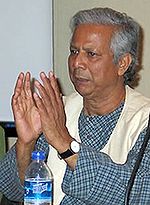7.6: Microfinance
- Page ID
- 5328

The Grameen Bank is a microfinance institution which distributes loans to people who, under normal circumstances, would never be able to open a line of credit. In any normal bank the lender requires the borrower to enter into a legally binding contract which guarantees the repayment of the given loan. If the borrower fails to repay the loan then their personal property is offered as collateral. The Grameen bank however requires no collateral and gives loans to those in the lowest socio-economic classes. The GB offers loans almost exclusively to women. Their current membership of 7.71 million is comprised of 97% women.[13] In order to raise the status of poor women, loans are almost always granted to them so that those who build new homes with their loans will have ownership of assets where traditionally women have had none. Instead of a contract the Grameen Bank requires users to apply for loans in groups of five or more. Although no one is responsible for the repayment of a loan other than the actual borrower herself, the other members of her group are there to help encourage her to repay her loan. Before a new group member can receive a loan, the other members loan must be paid off first. This creates strong peer pressure to pay back loans as quickly as possible. If someone is struggling to repay her loan, the GB will help them overcome their struggles and get back on their feet rather than take away the only source of income they have (traditional banking method). This unique perspective on lending inspires the attitude that all humans have great potential, that they only need the initial resources to show it. The Grameen Bank believes that the ability to receive credit is a human right, and that "these millions of small people with their millions of small pursuits can add up to create the biggest development wonder."[14]

Due to the success of the Grameen Bank the first Grameen based pilot program has begun in the US in Queens NY. Since its opening in January 2008 it has lent over 1 million US dollars to over 400 members. It is owned and operated by the international affiliate of the Grameen Bank in Bangladesh. Also, in 1997 the Grameen Foundation was created as a global non-profit organization which works around the globe to create microfinance institutions based on the Grameen model using a network of partner microfinance institutions.
There is criticism of microfinance as a solution to poverty. While microcredit institutions often report extremely successful stories of alleviating poverty in developing countries, some recent studies are presenting a different story. One research project conducted on women in Bangladesh found that only about 51 percent of the recipients of microcredit aid were regularly able to make their weekly payments. It also found that about one fourth of the loan recipients lied about the purposes for which they took out the loan.[15] One of the major problems is that many people take out loans for consumption purposes, such as marriage or medical expenses, rather than for investment in income generating activities.[20]


